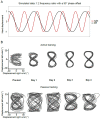Active versus passive training of a complex bimanual task: is prescriptive proprioceptive information sufficient for inducing motor learning?
- PMID: 22666379
- PMCID: PMC3359339
- DOI: 10.1371/journal.pone.0037687
Active versus passive training of a complex bimanual task: is prescriptive proprioceptive information sufficient for inducing motor learning?
Abstract
Perceptual processes play an important role in motor learning. While it is evident that visual information greatly contributes to learning new movements, much less is known about provision of prescriptive proprioceptive information. Here, we investigated whether passive (proprioceptively-based) movement training was comparable to active training for learning a new bimanual task. Three groups practiced a bimanual coordination pattern with a 1:2 frequency ratio and a 90° phase offset between both wrists with Lissajous feedback over the course of four days: 1) passive training; 2) active training; 3) no training (control). Retention findings revealed that passive as compared to active training resulted in equally successful acquisition of the frequency ratio but active training was more effective for acquisition of the new relative phasing between the limbs in the presence of augmented visual feedback. However, when this feedback was removed, performance of the new relative phase deteriorated in both groups whereas the frequency ratio was better preserved. The superiority of active over passive training in the presence of augmented feedback is hypothesized to result from active involvement in processes of error detection/correction and planning.
Conflict of interest statement
Figures






References
-
- Fitts PM, Posner MI. Human performance. Oxford, England: Brooks and Cole; 1967.
-
- Swinnen S, Lee T, Verschueren S, Serrien D, Bogaerts H. Interlimb coordination: Learning and transfer under different feedback conditions. Human movement science. 1997;16:749–785.
-
- Kovacs AJ, Buchanan JJ, Shea CH. Impossible is nothing: 5∶3 and 4∶3 multi-frequency bimanual coordination. Exp Brain Res. 2010;201:249–259. - PubMed
-
- di Pellegrino G, Fadiga L, Fogassi L, Gallese V, Rizzolatti G. Understanding motor events: a neurophysiological study. Exp Brain Res. 1992;91:176–180. - PubMed
-
- Fadiga L, Fogassi L, Pavesi G, Rizzolatti G. Motor facilitation during action observation: a magnetic stimulation study. J Neurophysiol. 1995;73:2608–2611. - PubMed
Publication types
MeSH terms
LinkOut - more resources
Full Text Sources
Medical

